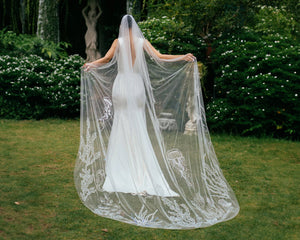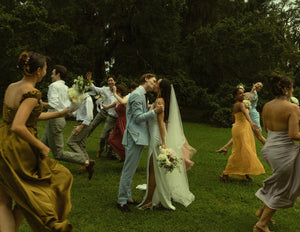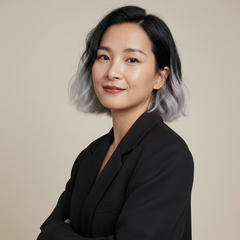You may also like
There's something deeply magical about a wedding veil. Whether choosing classic or modern veils, brides find ways to express their unique vision through this timeless accessory. With a single sweep of fabric, it can transform a bride into a vision of elegance, romance, and mystery.
Through ancient beginnings rooted in superstition to modern interpretations driven by self-expression, the wedding veil is a testament to love, culture, and personal style.
Let’s dive deep into the fascinating history of this timeless accessory, its rich symbolism, enduring traditions, and the exciting trends shaping its future.
Ancient Beginnings: Protection and Symbolism
Superstition and Spirituality
The veil’s origins stretch back thousands of years, with its first recorded use in ancient Mesopotamia and later in Ancient Greece and Rome. Even in its origins the veil went beyond decoration to serve a protective purpose for both bride and groom. Brides wore brightly colored veils, often red or yellow, to ward off evil spirits that might threaten their happiness or the success of the union.

An ancient Rome wedding. source: SPQR | Ancient Rome and the Ancient World
In Roman culture, the flammeum, a flame-colored veil, entirely covered the bride, symbolizing the great transformation in her life that was marriage. The veil also continued to hold meaning as a protective garment against those who would wish harm on the happy couple.
A Gesture of Modesty
In early Christian and Jewish traditions, the veil was a symbol of purity, humility, and reverence for God. Covering the bride’s head and face emphasized her transition into a sacred covenant. While its meaning has evolved, the veil remains an integral part of wedding ceremonies, sometimes tied to religious significance.
The Veil as a Status Symbol
Throughout history, veils have also been a marker of wealth and social status. During the Middle Ages and Renaissance periods, elaborate veils made from silk, lace, and fine linens adorned noblewomen and royalty. These veils often featured intricate embroidery or were embellished with pearls and gemstones to showcase the affluence of the bride and her family.
When Queen Victoria married Prince Albert in 1840, it marked a pivotal moment in the history of wedding veils. Her choice of a white wedding dress paired with a delicate Honiton lace veil set a precedent that defined bridal fashion for generations. The simplicity of her veil highlighted her modesty and grace, yet its fine craftsmanship spoke volumes about her royal stature. This single event solidified the white wedding veil as a universal bridal tradition.
Cultural Traditions: A Global Tapestry
Asian Wedding Veils: Vibrance and Symbolism
In many Asian cultures, veils serve both symbolic and practical purposes. In some regions of India, brides often wear a ghoonghat, a long veil or scarf, draped over their heads and faces as a symbol of honor and modesty. Similarly, Chinese brides may wear a red veil or hood to bring joy, luck, and prosperity to their union.
Middle Eastern Veils: Intricate Beauty
Middle Eastern brides often wear veils adorned with intricate beadwork, embroidery, and metallic threads. These veils are as much about artistry as they are about evoking modesty, showcasing cultural pride and craftsmanship.
Western Customs: The Romantic Unveiling
The Western tradition of lifting the veil has romantic roots that stretch deep into old soil. Historically, veils concealed the bride’s face until the ceremony’s conclusion, when the groom would unveil her as a symbolic gesture of acceptance and the bride’s transition into married life. This act has evolved into a moment of intimacy and love in modern weddings.
The Transformation of Veils in Modern Weddings
As time progressed, the meaning of the veil shifted from tradition and modesty to fashion and individuality. Modern brides now use veils to express their unique tastes and personality, while complimenting their gown in a way that helps tell the story of their marriage.
Versatility in Lengths
Veils today come in a variety of lengths, each with its own charm and significance:
- Cathedral-length veils offer drama and grandeur, perfect for formal ceremonies.
- Chapel-length veils are slightly shorter but still elegant, adding sophistication without overwhelming the bride’s silhouette. Versatile veils that work in any venue.
- Fingertip and elbow-length veils are versatile and practical, making them popular choices for modern brides. Fingertip and elbow-length veils will thrive in outdoor wedding spaces where they are allowed to float on the breeze.

Bride: Dani Eble - Washington, USA. Photo: Megan Jo. Veil: Kaitie
Breaking Tradition with Color
While white and ivory remain timeless, colored veils have grown in popularity. Soft hues like blush, champagne, and even pastel blue or lavender are emerging as favorites for brides seeking a fresh take on tradition. These colors often add a layer of personality while still maintaining a romantic vibe.
A Return to Craftsmanship
In recent years, there’s been a resurgence in veils featuring detailed craftsmanship. From hand-embroidered lace to 3D floral appliqués and shimmering beadwork, these veils highlight the artistry of bridal fashion. Modern brides embrace bespoke designs that incorporate personal elements—such as initials, meaningful quotes, or symbolic motifs.
Modern Trends Shaping the Future of Wedding Veils
Sustainability and Heirlooms
With sustainability becoming more and more a priority, many brides are choosing vintage veils or repurposing family heirlooms. Others are investing in high-quality veils that can be passed down to future generations, creating a meaningful legacy. Sustainable bridal fasion creates an avenue for the bride to express both deep connection to family history, and the values her partnership brings to their union through practicing green living.
Detachable Veils
Detachable veils are growing in popularity for their practicality. Brides can enjoy the drama of a cathedral-length veil during the ceremony and remove it for an unencumbered reception look. This trend bridges the gap between classic vs modern wedding veils , offering the best of both worlds.
Whimsical Themes
For brides planning uniquely themed weddings—such as bohemian, celestial, or ocean-inspired celebrations—veils are the bride’s canvas for creative expression. For example, veils featuring stars, blooming flowers, or even marine motifs allow brides to connect their look to the overall theme.
Symbolism in the Modern Era
While the veil’s meaning has changed over time, its symbolism remains powerful. For some brides, it’s part of their cultural heritage passed down through tradition. For others, it’s an expression of their individuality and the love story they’re beginning to write.
The act of donning a veil, regardless of its design, carries a sense of ceremony. It marks a transition—a moment when the bride steps fully into the spotlight, ready to embrace a new chapter of life with her partner.
How to Choose the Right Veil
Selecting the perfect veil is as personal as choosing the wedding dress itself. Here are a few tips to help brides find the one that speaks to them:
-
Consider Your Dress
The veil should enhance, not overshadow, your gown. For dresses with intricate detailing, opt for a simple veil. For minimalist gowns, a veil with embellishments can add just the right amount of flair. -
Think About the Venue
Outdoor venues may require shorter veils that are easier to manage, while grand indoor settings can accommodate longer, more elaborate designs. -
Reflect on Your Personality
Your veil is an extension of your personality. Whether you’re drawn to classic lace, bohemian tassels, modern, clean lines, or something entirely your own, don’t be afraid to think outside the box. Choose a veil that feels authentically you.
Read our blog if you are confused to choose your perfect veil: How to Choose the Perfect Veil Length for Your Wedding Dress
The Enduring Allure of the Wedding Veil
What makes the wedding veil so special? Perhaps it’s the way it balances tradition and modernity, mystery and revelation. For centuries, it has symbolized love, purity, and hope. Today, it continues to captivate brides around the world, offering them a chance to honor the past while embracing their future.

Anna Dietrich, MI USA. Photo: Veil: Cassandra from Beaded wedding veils collection. Photo: Lydia Charles
Whether you're walking down the aisle in a cathedral-length masterpiece or a playful blush-colored veil, know that you're participating in a tradition that has spanned cultures, centuries, and continents. Today's modern brides wearing veils continue to reinvent this timeless accessory, making it uniquely their own. The veil is your story, woven into fabric, telling a tale of love that's as timeless as the union it celebrates.
As you prepare for your big day, remember: your veil isn’t just something you wear. It’s a piece of history, a symbol of romance, and, most importantly, a reflection of you.








